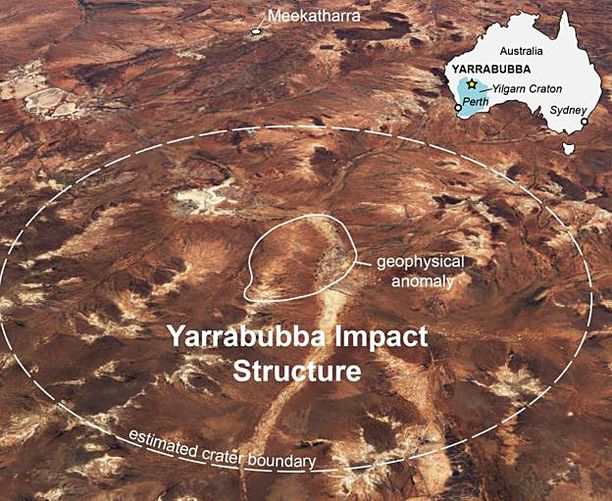Maahan 2.2 miljardia vuotta sitten iskeytynyt asteroidi oli halkaisijaltaan noin 7 kilometriä ja se synnytti 70 km. kraatterin.
Amy Schleunes
At 2.229 billion years old, the Yarrabubba crater is older than both the Vredefort Dome in South Africa (2.023 billion years old) and Canada’s Sudbury Basin (1.850 billion years old), report the authors in the study. These are the only other precisely dated Precambrian impact structures that are currently known. Yarrabubba’s estimate has a margin of error of just 5 million years.
Originally stretching roughly 70 km wide, the Yarrabubba resisted reliable estimates of its age because of erosion and plate tectonics. It is now an elliptical structure with a diameter of approximately 20 km. Geochronologist Timmons Erickson of the NASA Johnson Space Center and his colleagues sought to assign the crater an exact age by studying concentrations of uranium, thorium, and lead in rocks collected from the crater.
The team submerged the rocks in water, exposed them to electricity, and searched the grains for zircon and monazite, reports The New York Times. “Zircon and monazite are two of the most commonly used uranium lead geologic clocks,” Erickson writes in an email to Gizmodo. “Because their crystal structure can incorporate uranium—but not lead—when they crystallize, and uranium will decay to lead at a known rate, we can use the ratios of the uranium and lead isotopes to determine their age.”
That newly determined age coincides with “a dynamic time in the evolution of Earth following the transition from the Archaean to the Proterozoic eon,” the authors write in the paper, describing the end of an ice age. “Would an impact event like Yarrabubba be enough to terminate a glacial time in Earth’s history?” Erickson asks in an interview with The New York Times.
Using a computer simulation, Erickson and his team modeled the atmospheric effects of the asteroid collision, finding that vaporized ice could cause “between 9 × 1013 and 2 × 1014 kg of water vapour being jetted into the upper atmosphere within moments of the impact,” according to the study.
“We postulate that a Yarrabubba-sized impact into an ice sheet would have released significant water vapor, which is an even more efficient greenhouse gas than carbon dioxide,” Erickson tells Gizmodo. “If the residence time of water in the Earth’s atmosphere was long enough, this could create significant warming of the planet’s atmosphere, however, additional climate models are required to prove if this is a viable mechanism to warm Earth’s surface.”
Geochemist Christian Koebel of the University of Vienna who was not involved in the study tells The New York Times that extrapolating past climatic events from current data is “where things get a lot more speculative. We just don’t know the answer to that yet.”

Ei kommentteja:
Lähetä kommentti